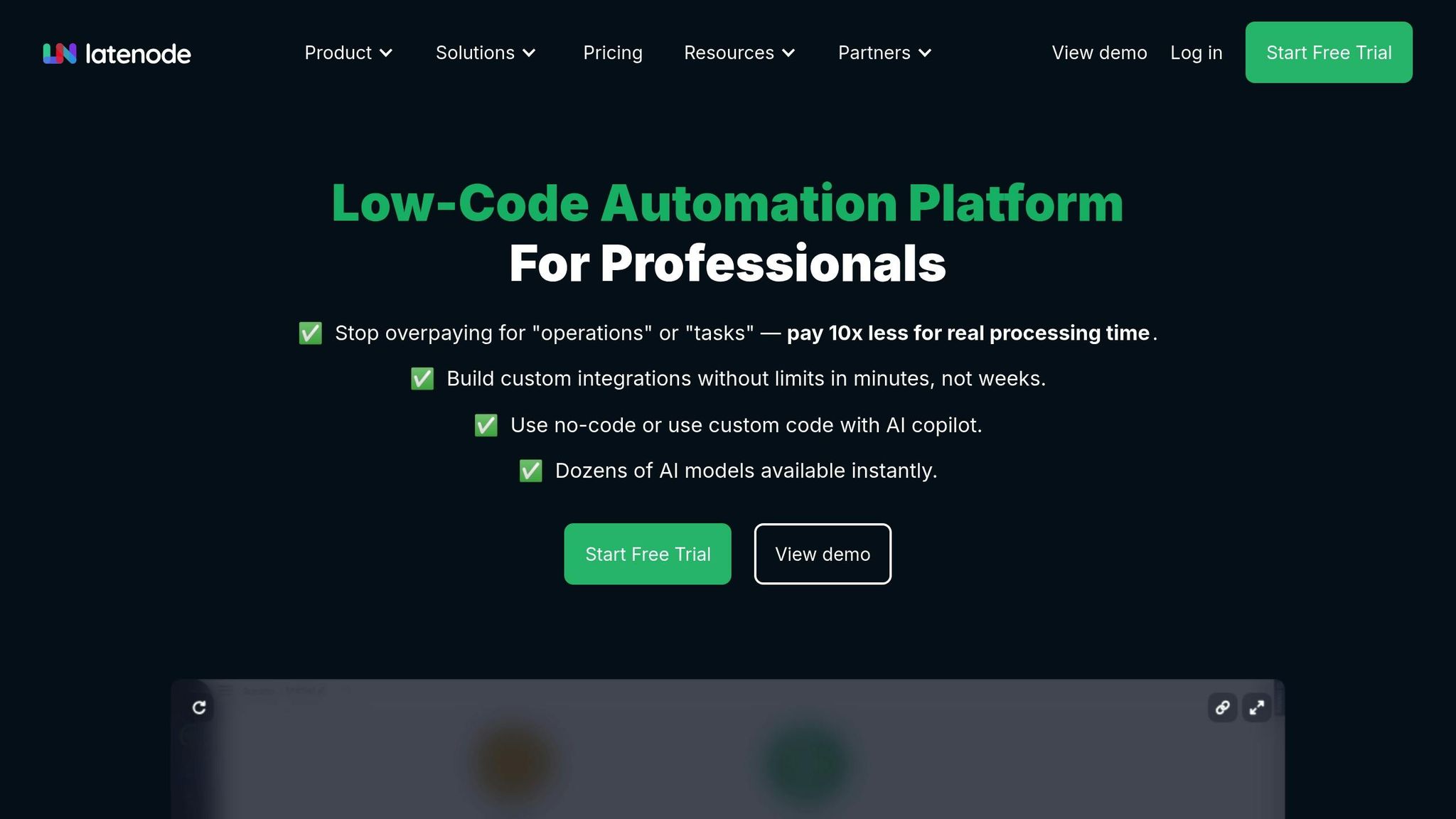


Only 20% of tasks in most workflows require human judgment - the rest can be automated.
This article introduces knowledge agents: AI systems that combine data gathering, querying, and action-taking to automate complex workflows. These systems rely on structured knowledge bases, logical rules, and low-code platforms like Latenode to streamline operations.
You’ll discover:
Let’s break down how knowledge agents work and how they can transform your workflows.
Knowledge-based systems rely on structured rules and defined processes to make logical, informed decisions. These systems are a cornerstone of modern AI agents, enabling them to handle complex information and automate essential business workflows efficiently.
At their core, these systems operate through a three-layer model consisting of a knowledge base, an inference engine, and a dynamic adjustment layer. Here’s how these components work together:
This structured approach ensures logical consistency and makes these systems highly reliable for decision-making tasks across various industries.
Using these structured methods, AI agents excel in tasks that demand precision and traceable decisions. They are particularly effective in industries that rely on strict regulations or logical workflows.
For instance, in telecommunications, when a customer requests instructions to reset a router, the system retrieves relevant data, processes it, and provides clear, step-by-step guidance. The system also updates its knowledge base when new technical information becomes available, keeping its responses accurate.
Similarly, in logistics, a shipping management system relies on predefined rules to determine optimal routes, calculate shipping fees, and ensure compliance with customs regulations. By regularly updating its knowledge base with new rules and policies, the system ensures that all processes meet current standards.
These systems are especially valued for their ability to:
Low-code platforms make AI development accessible, allowing organizations to create intelligent systems with minimal coding expertise.
Low-code tools enable quick deployment, adapt to changing business needs, and involve non-technical teams in the process. This approach combines speed with the ability to tailor solutions to specific requirements.

Latenode builds on these advantages by offering features that simplify workflow automation:
Visual Workflow Builder
Latenode includes an easy-to-use visual canvas where users can design automation flows through a drag-and-drop interface. This approach helps teams map out processes clearly while accommodating advanced logic.
AI-Assisted Development
The platform’s AI Code Copilot guides users through the automation process. As automation specialist Sophia E. puts it:
"Latenode is a cheaper but powerful alternative to the usual AI automation tools. It's easy to use, even for beginners, thanks to its simple and intuitive interface. I only know the basics of Java, C++, and C" [1].
Integrated Database System
Latenode features a built-in database system, simplifying data management within workflows. This eliminates the need for external databases, making development more efficient.
Custom Code Options
For users needing advanced control, Latenode supports custom coding. Web developer Francisco de Paula S. highlights this feature:
"The AI javascript code generator node is a life saver, if you get to a point in the automation where a tool or node is not yet created" [1].
These tools make it easier for both technical and non-technical users to create effective automations. Small business founder Charles S. shares:
"My favorite things about LateNode are the user interface and the code editor. Trust me, being able to write 'some' of your own code makes a huge difference when you're trying to build automations quickly." [1].
Knowledge agents are transforming how businesses operate by automating tasks that involve complex information processing. For example, a contract automation company using Latenode experienced impressive outcomes: lead generation increased by 62% (from 500 to 810 leads monthly), engagement rates improved by 45% (from 20% to 29%), response times were reduced by 80% (from 24 hours to just 4.8 hours), and personalized communications doubled (from 20% to 50%). These improvements free up teams to focus on more strategic tasks while automation handles repetitive processes.
Typical use cases include:
Implementing Latenode-powered knowledge agents offers several operational benefits but also comes with some challenges. Here’s a breakdown of the key considerations:
| Aspect | Advantages | Limitations |
|---|---|---|
| Efficiency | - Reduces manual follow-up time - Operates 24/7 - Automates routine decisions |
- Requires thorough initial planning - Needs periodic adjustments |
| Accuracy | - Reduces data entry errors - Ensures consistent processing standards - Enforces compliance rules |
- Relies on data quality - Needs clear business rules |
| Scalability | - Handles increased workloads - Replicates successful processes - Supports multiple communication channels |
- May require infrastructure upgrades - Requires monitoring at scale |
| Cost Impact | - Cuts operational expenses - Optimizes resource allocation - Boosts productivity |
- Involves upfront investment - Includes training costs for staff |
These results showcase the practical benefits of knowledge agents, such as improved efficiency, accuracy, and scalability. However, they also highlight the importance of careful planning and ongoing management. Businesses leveraging Latenode can build tailored automation solutions that align with their specific needs, ensuring they achieve the best possible outcomes from their knowledge agent deployments.
Here’s how you can set up knowledge agents in Latenode to streamline your workflows.
Use these practices to enhance your workflows and achieve better results:
Take Advantage of Built-in Features
Latenode’s built-in database simplifies workflow management by storing frequently accessed data and maintaining context between automation runs.
"AI Nodes are amazing. You can use it without having API keys, it uses Latenode credit to call the AI models which makes it super easy to use. Latenode custom GPT is very helpful especially with node configuration." [1]
Plan for Errors
Incorporate error-handling mechanisms to ensure your workflows remain reliable:
| Error Scenario | Recommended Action | Implementation Method |
|---|---|---|
| API Timeout | Automatic retry | Use retry logic with exponential backoff |
| Data Validation Failure | Use an alternative path | Add branching logic with data validation nodes |
Boost Workflow Efficiency
Track execution times and resource use through Latenode’s execution history feature. This helps you spot areas where performance can be improved.
"The AI javascript code generator node is a life saver, if you get to a point in the automation where a tool or node is not yet created to interact with Latenode, the AI…" [1]
Example: Building a Telegram Bot with AI Responses
For a practical example, here’s how to create a Telegram bot powered by AI:
This setup highlights how Latenode simplifies AI-driven communication workflows.
AI-powered knowledge agents are transforming how businesses handle workflows and process information, making it easier to make data-driven decisions while saving time and resources.
By combining AI with low-code platforms like Latenode, businesses can access advanced automation tools without needing extensive technical expertise. Latenode’s execution time–based pricing model can deliver up to 10x cost savings, making it an efficient choice for organizations of all sizes [2].
The impact of these tools is evident in real-world applications. For example, an Education Management team successfully automated form submissions from Google Sheets, enabling them to generate personalized emails seamlessly [2].
"AI Nodes are amazing. You can use it without having API keys, it uses Latenode credit to call the AI models which makes it super easy to use" [2].
To maximize the benefits of automation, organizations should begin with clear goals and gradually scale their efforts. Latenode’s visual workflow builders and AI-powered tools provide businesses with the flexibility and control needed to create even the most complex automation scenarios.
Knowledge agents stand out from traditional AI systems by relying on a structured knowledge base to drive logical and transparent decision-making. Unlike traditional AI, which often uses complex algorithms that can be difficult to interpret, knowledge agents excel in tasks where clear, rule-based reasoning is essential.
These agents are particularly effective in real-world scenarios requiring traceable decisions, as every action is based on predefined rules and curated information. This makes them ideal for industries where compliance, accuracy, and accountability are critical, such as business productivity or marketing automation.
Low-code platforms like Latenode simplify the creation of AI-powered workflows by offering a user-friendly interface and powerful tools. With features like no-code nodes and the ability to integrate custom code, you can easily connect services and build workflows tailored to your needs.
Latenode’s AI assistant further enhances efficiency by generating ready-to-use code based on your input, saving time and effort. You can also design custom logic, seamlessly link APIs, and create unique endpoints, all without requiring extensive technical expertise. This makes it an ideal solution for automating tasks and optimizing operations quickly and effectively.
Integrating knowledge agents into existing business systems is generally achievable but may come with some challenges. Common obstacles include ensuring data privacy and security, achieving compatibility with older or legacy systems, and addressing potential resistance from employees.
To overcome these challenges, businesses can adopt strong encryption methods, follow relevant data protection regulations, and use middleware or APIs to bridge compatibility gaps. Additionally, involving employees early in the process and providing clear communication and training can help ease the transition and foster acceptance.



